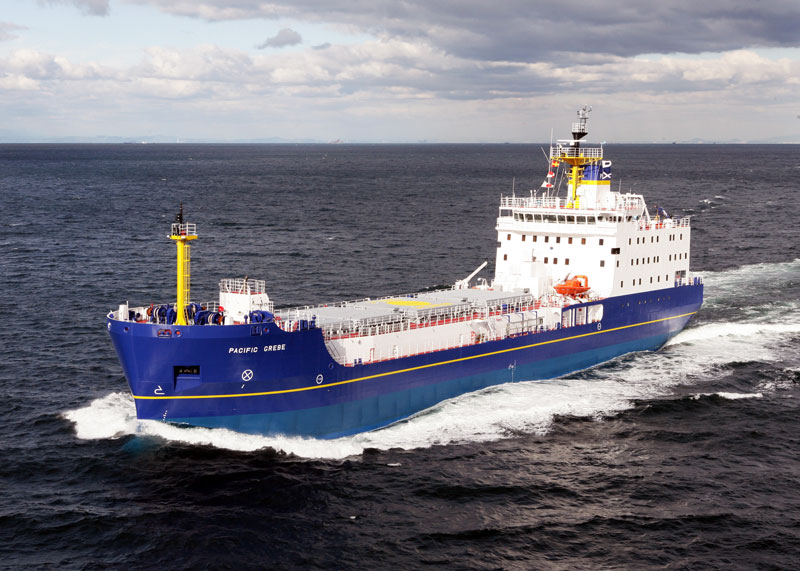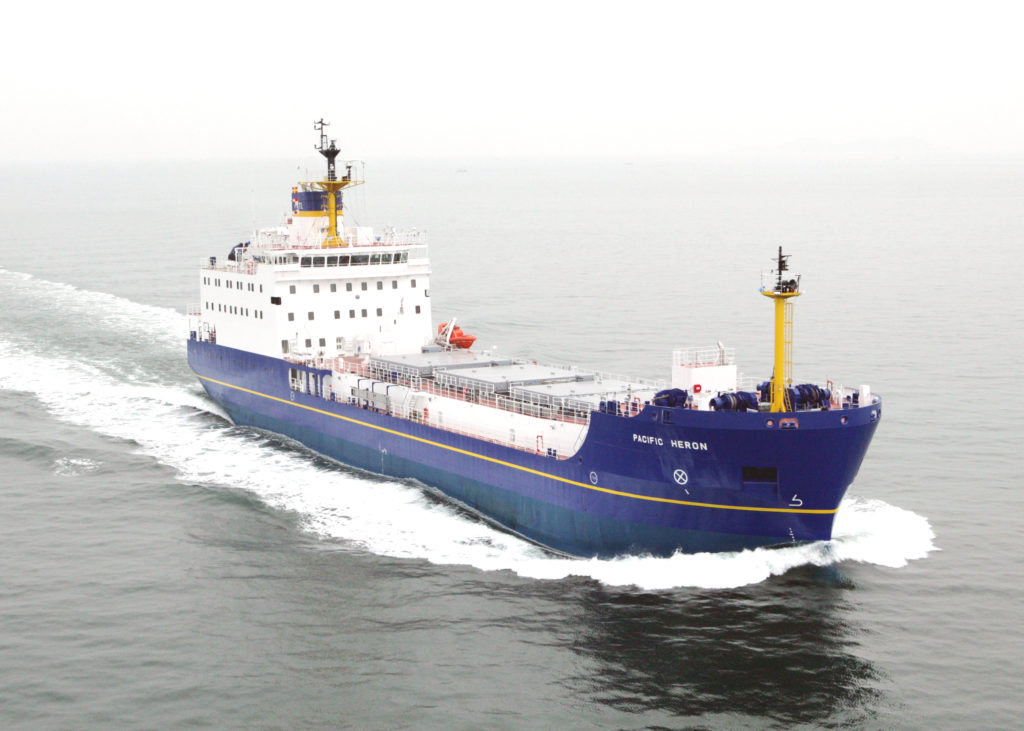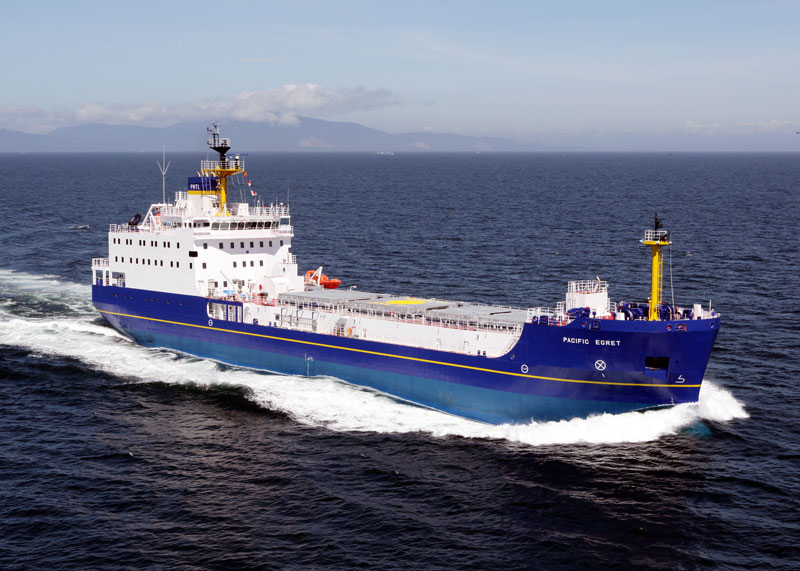Pacific Grebe

The third of the new generation of PNTL vessels
The Pacific Grebe, delivered in 2010, is an INF 3 certified vessel under the INF Code of the International Maritime Organization (IMO).
This vessel is the third of the new generation of PNTL vessels and, like its sister ships the Pacific Heron and Pacific Egret, its design builds on the experience of operating purpose-built nuclear carriers since 1979. The Pacific Grebe is primarily designed for shipping conditioned nuclear waste. Pacific Grebe entered full service in 2011.
Factbox
| Length overall | 103.92m |
| Breadth | 17.25m |
| Draft | 6.75m |
| Number of hold | 4 |
| Capacity | 20 flasks |
| Design speed | 14 knots |
| Deadweight (max) | 4,916 tonnes |
| Principle cargo carried | high level waste/compacted waste |
Safety in depth
PNTL’s cargoes are protected by the transport packages containing the nuclear materials. These packages are designed, modelled and tested to international standards set by the International Atomic Energy Agency (IAEA). The design of the Pacific Grebe, like her sister ships the Pacific Heron and the Pacific Egret, represents one of a series of further barriers to protect its cargo. It has a double hull throughout and impact resistant structures between the hulls.
The vessel also has duplication and separation of all the essential systems to provide high reliability and accident survivability. This means that if any important system fails during a voyage, either due to mechanical failure or as a result of an accident, there is always a backup system ready to be
brought into operation.
In addition, no tanks or spaces containing oils or other pollutants are positioned directly adjacent to the outer hull in order to ensure that there is no pollution should a tank be ruptured during an incident.
In summary the key safety features are:
- double hull throughout, with additional strengthening surrounding the holds
- separate machinery and steering gear rooms
- hold cooling plant located outside holds for easier maintenance
- integrated bridge system
- no oil tanks adjacent to outer hull
- security features incorporated into design
- improved environmental and safety performance
- advanced fire detection and fire fighting systems
In the unlikely event of a ship getting into difficulty, a fully trained and equipped team of marine and nuclear experts is available on a 24-hour emergency standby system, in line with IAEA requirements. The world’s leading salvage experts, SMIT, are also contracted to support any unforeseen circumstances PNTL ships may face and the ships are equipped with a specialist system to assist in their location and subsequent salvage, should the unlikely need arise
Security
The international regulators providing guidance for the protection of nuclear material are the International Atomic Energy Agency (IAEA) and its Member States, and in the European Union, Euratom. Nuclear cargoes require security measures and prior to each shipment a transport security plan
is prepared, in accordance with the regulations, documenting the specific arrangements to ensure security of the cargo.
The specific regulations and guidelines that are met or exceeded by the design and operation of the Pacific Grebe are as follows:
- NISR 2003 – UK Nuclear Industry Security Regulations
- Convention on the Physical Protection of Nuclear Material (IAEA publication INFCIRC 274)
- Recommendations on the Physical Protection of Nuclear Material published by the IAEA (INFCIRC 225)
Crew
PNTL’s crews are among the most experienced nuclear cargo mariners in the world. The Pacific Grebe will carry a crew which is substantially larger than that found on chemical tankers of a similar size. All senior navigating and engineering officers hold certificates of competence for a higher rank than the one they serve. For example, the Chief Officer must hold a Master’s Certificate. In addition all personnel are actively encouraged to enhance their skills and qualifications and to take relevant training courses.
Regulations
The Pacific Grebe’s design and operation meets all of the following requirements:
- United Kingdom Maritime and Coastguard Agency (MCA) regulations
- Japanese Ministry of Land, Infrastructure, Transport and Tourism (MLIT) regulations
- International Convention for the Safety of Life at Sea (SOLAS),which sets standards for the safe operation of vessels
- INF code: International Code for the Safe Carriage of Packaged Irradiated Nuclear Fuel, Plutonium and HighLevel Radioactive Wastes on Board Ships
- The International Convention for the Prevention of Pollution from Ships (MARPOL), which protects the marine environment from pollution by vessels
- IMO International Maritime Dangerous Goods (IMDG) Code applicable to radioactive materials
- IMO International Safety Management Code (ISM Code)
- IMO International Ship and Port Facility Security Code (ISPS Code)
- The United Nations Convention on the Law of the Sea (UNCLOS), which recognises the principles of the right of innocent passage through territorial seas and the freedom of navigation beyond; and also that vessels carrying nuclear substances must carry documents and observe special precautionary measures when exercising the right of innocent passage through territorial seas.
Our fleet

Pacific Heron
The Pacific Heron, delivered in 2008, is an INF 3 certified vessel under the INF Code of the International Maritime Organization (IMO).
Pacific Heron
Pacific Egret
The Pacific Egret, delivered in 2010, is an INF 3 certified vessel under the INF Code of the International Maritime Organization (IMO).
Pacific Egret
Pacific Grebe
The Pacific Grebe, delivered in 2010, is an INF 3 certified vessel under the INF Code of the International Maritime Organization (IMO).
Pacific Grebe